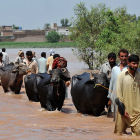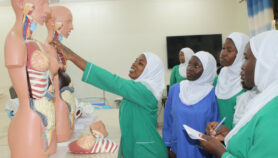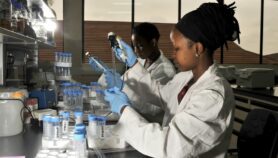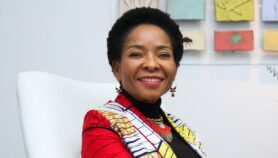Send to a friend
The details you provide on this page will not be used to send unsolicited email, and will not be sold to a 3rd party. See privacy policy.
Science and technology can seem remote from the unfolding dramas of the world but they were never far from the front line in the first months of the Arab Spring.
When revolution broke out in Egypt’s Tahrir Square in January, scientists were there in force, helping to plant the seeds of change. When dictatorship was replaced by a move towards a more democratic system of government that openly encourages debate and dissent, and is more committed to meeting the social needs of their people, science began to germinate in Egypt and elsewhere.
Thus, the swift announcements in Egypt of the planned construction of the new Zewail City of Science and Technology, of an ambitious science spending plan and, later, of a national research network. Scientists in Egypt also felt they could speak out against what they saw as inappropriate development.
And, in reformed Tunisia, plans were announced to boost its science and technology with a US$16.5 million project.
Events during next year , particularly in Egypt, may provide a case history in the links ― or otherwise ― between greater political freedom and greater support for science.
Social media
At the same time, science-based technology played its part in achieving freedoms. The role of social media in fostering the revolts of the Arab Spring has been discussed exhaustively but social media ― and their versatile vehicle, the mobile phone ― achieved much in other fields as well, making 2011, surely, the year in which the phenomenon came of age in the field of development.
Whether it is has been providing access to insurance for smallholders in East Africa, or helping during disasters such typhoons in the Philippines social media has been fixing development gaps all over the world.
Indeed, science and technology have had increasing amounts to offer the fields of both disaster warning and disaster response ― giving science another reason to be mixed up in headline world events.
The Japanese earthquake and tsunami in March, for example, highlighted ever-more ingenious ideas for adding vital seconds to tsunami warning times, from the detection of airglow fingerprints in the sky to the use of radar and global positioning systems (GPS); while tsunami early warning systems were tested both at a continental and local level.
In the case of the Horn of Africa drought, scientists were there before it happened, their early-warning systems forecasting famine. But the message did not lead to action, exposing the psychological and political difficulties faced by scientists and politicians alike when talking about risks rather than certainty.
Science of disaster
Given both its successes and failures, it is little surprise that there was much debate this year about the potential use of scientific data in preventing, or giving early warning about, disasters.
An American scientist made the controversial allegation that the 2010 floods in Pakistan could have been forecast far in advance using information already existing in Europe ― a claim that annoyed meteorologists in Pakistan.
Meanwhile, Thailand‘s researchers have made progress on a ‘super floodway’ to prevent flood damage and Philippine researchers have invented a cheaper version of landslide detectors.

A debate erupted over whether Pakistan’s devastating floods could have been predicted
Flickr/IRIN Photos
The growing feeling that science has much to contribute in the prevention, early warning, rescue and recovery phases of disasters, was expressed in the Humanitarian Emergency Response Review, a report launched by the UK‘s Department for International Development earlier in the year.
Meanwhile, the Integrated Research on Disaster Risk programme held its inaugural meeting in October, in Beijing, and plans to get scientists from many disciplines working together on disaster prevention.
Never far from discussions about natural disasters was the role of climate change, a phenomenon which preoccupied South Asia in particular in 2011, given its exposure to extreme weather conditions. Adaptation to these conditions and the other effects of global warming, in particular, was rarely out of the science news.
Least developed countries in the region took the lead, reflecting their growing concerns about their future.
A conference in Bangladesh underscored the idea that science is the key to adaptation strategies; while a climate summit in Bhutan saw four South Asian countries pledging to draw up a joint adaptation strategy.
A new inventory of Himalayan glaciers was released by the International Centre for Integrated Mountain Development in Nepal, while flood-hit Pakistan put up its climate change strategy for cabinet approval and is expanding its glacier monitoring network for better understanding of the impact of glaciers on flood hazards.
Further east, in the Pacific region, climate models and maps are being combined with locally generated information to try and understand the impacts of climate change.
In such ways, science has demonstrated that it has a lot to contribute to the solution of environmental problems.
Global impediments
But achieving this potential can often require international agreement. And the extent to which political and financial complexities on the international stage can prevent such agreement being reached was vividly illustrated this year.
At the UN Climate Conference in Durban (COP 17) in December, for example, progress was slow despite the exasperation of the vast majority of climate scientists.



Progress on international agreements in conferences such as the Durban climate summit was slow
Flickr/UNclimatechange
At the Eye on Earth Summit in Abu Dhabi, also in December, we learned of the vast quantities of data that already exist, which could be put to environmental use if only the diplomacy and finances were amenable.
And, even as the General Assembly of the International Council for Science (ICSU), held in Italy two months previously, was agreeing on major programmes relating to science and humanity, some voices were asking whether more time and money should not instead go into making better use of existing scientific knowledge to persuade the global public of the need for urgent environmental action.
These debates will grow in 2012 in the build-up to the UN Conference on Sustainable Development (Rio+20), in June, in Brazil. To many, they illustrate the limits to collective action and shared responsibilities that can exist when either political or financial tensions rise to the surface.
For some, this means that science is most effectively promoted at regional, national and even local levels, where such tensions can be taken into account more easily, and policies adapted to local political conditions.
The price, however, is that where these local conditions are not favourable, science may not flourish.
As developing countries reacted to the catastrophe at Japan’s Fukushima nuclear plant, it was clear that, while the disaster buffeted many national debates on nuclear power, the outcomes of those debates ― ranging from closure of power stations to vigorous pursuit of the nuclear option ― depended on local politics.
Highs and lows in Latin America
Latin America has provided a good example of the ebb and flow of support for science and the varying amounts of political clout scientists are therefore able to exercise at national levels.
Chile and Uruguay, for example, increased their spending on science and technology (S&T) in 2011. Paraguay launched a plan to develop a science and funding policy, and Colombian scientists successfully made a case for greater funding in the debate about what to do with mining and energy royalties.
But, in Venezuela, changes to the science law made in 2010 and implemented in 2011 led to protests about the waning independence of research centres and private firms, and forecasts of a dramatic curtailment of science and technology.
In Peru ― which has one of the lowest science and technology budgets in Latin America ― the new president, Ollanta Humala, announced that S&T would be a core feature of his proposed model of development. But the Peruvian government then failed to raise the S&T budget for 2012 above its existing level of 0.1 per cent of the national budget.
Similarly, in Mexico, for the seventh consecutive year the government has not respected its own science law, which stipulates that one per cent of the gross domestic product (GDP) should be invested in science, despite campaigns by scientists and business people.
The most watched nation in Latin America is, of course, Brazil, where science funding soared over last decade, and the nation became a beacon for the developing world.
But the curve is now broken: for the first time in almost a decade, an eight per cent drop was announced in 2011 compared with 2010’s funding high of around US$3.3 billion. The promise is that, in 2012, the budget will rebound to a new high of more than US$3.4 billion.
The weak political strength of the Brazilian scientific community in 2011 was illustrated by the failures of scientists to influence discussions on a planned forest code, and on how to share the royalties from newly discovered oil fields found in the Atlantic seabed. Both decisions were postponed till next year.



The electric car from Uganda highlighted growing African innovation
Makerere University
Africans take charge
African politicians, meanwhile, demonstrated a growing interest in the value of S&T, and particularly innovation, in 2011, while combining this with a growing conviction that Africans need to drive innovation themselves.
The easy part of this philosophy is rejecting donor funding ― Uganda did this, for example, by kicking away support from the World Bank’s Millennium Science Initiative.
The difficult bit is replacing the external money on which much of African science depends with indigenous funding sources ― something that Uganda has yet to do.
There are, however, growing examples of Africans doing science and innovation for themselves.
In 2011, these included the slow and painful piecing together of the Pan-African University; the publication of the pioneering African Innovation Outlook, which charts science and innovation in 19 African countries; and discussions about a African Higher Education research space.
If some of those innovations are too abstract to contemplate as the year winds down, think instead about a small, green metallic phenomenon seen racing around the grounds of Uganda’s Makerere University last month.
The electric car, built by the university’s scientists and students, is fast becoming a symbol that Africa‘s time for home-grown innovation may have come.













